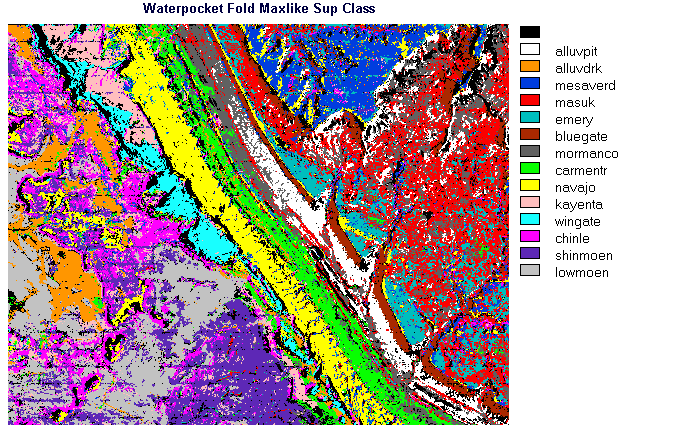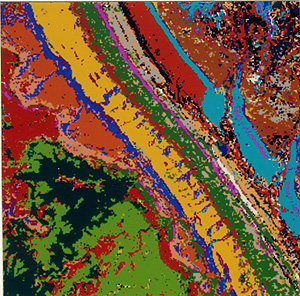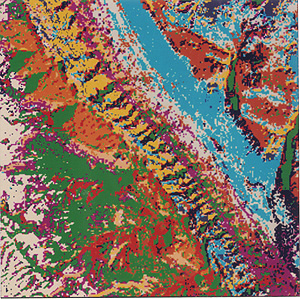

Its accuracy is an estimated 70%; that is, the rock units or formations are correctly identified over at least that percentage of surface exposures (chief sources of error: soil cover and similar lithologies). This is high in view of shadow and slope effects, soil cover, and other variables. Among variable misidentifications and conflicts: The Navajo palette color also occurs in the prospect pits and along canyon walls on Tarantula Mesa; black areas assigned to the localized Carmel/Entrada (combined because of a 15 class limitation) are scattered throughout the scene; Kayenta almost disappears in the south except where it shows up incorrectly west of the Chinle (which itself is not well mapped); colors assigned individually to the Morrison/Mancos and, the Masuk and the Emery Formations are dispersed within each other. Note too that the Upper Moenkopi and Shinarump Formation were combined because the latter is too thin in outcrop area to be mapped discretely at this resolution.
There can be considerable subjectivity in setting up and interpreting any classification. Two more of the Waterpocket Fold are shown below to demonstrate how changing factors lead to modified results. Both were made on the IDIMS system at the Goddard Space Flight Center.

The upper classification works on the same summer 1984 scene but applies a different set of training sites and, unlike the one above, includes thermal band 6. The resulting distinctions of the formations present are exceptionally good. Red was assigned to alluvium which, for the most part, was corrected placed (the large section of red occupying the Blue Gate shale member [in blue] of the Mancos Formation corresponds to strongly weathered slope wash along steep slopes against Tarantula Mesa. The Dakota Formation is rendered a wine purple color assignment (but the white strip near it is of unknown character). The Kayenta is singled out in reddish-brown; the Chinle is pinkish-peach.

The illustration above is a classification of a Landsat scene acquired during the winter of 1985. Results are less compellingly positive, although many of the units still are primarily where they shoul be. The various formations within the monoclinal limb are discernible but with more irregular outcrop patterns (and include more patches of other units). (Note the black patches which are shadows in erosional alcoves.) The Moenkopi is not subdivided into Upper and Lower in this winter version. The light grayish-tan patches along the left side of the image mark snow cover.
On the whole, the Waterpocket Fold has proved an exceptional test site. Its field characteristics are especially suited to enhancements like PCA and ratioing. The abundant exposures of rocks rather than soil and vegetation cover favor ready discrimination and hence higher classification accuracies than is the case for most geological units, particularly those in areas where the units are hidden by weathering products and organic growth. As has always been known for aerial photographs, space imagery has limited value for direct mapping in vegetated terrains, so that there field observations requiring on-site inspection and even digging remain the traditional way to map rock units.
Code 935, Goddard Space Flight Center, NASA
Written by: Nicholas M. Short, Sr. email: nmshort@epix.net
and
Jon Robinson email: Jon.W.Robinson.1@gsfc.nasa.gov
Webmaster: Bill Dickinson Jr. email: rstwebmaster@gsti.com
Web Production: Christiane Robinson, Terri Ho and Nannette Fekete
Updated: 1999.03.15.